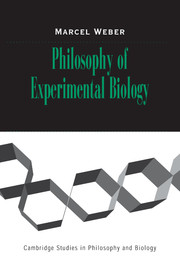Book contents
- Frontmatter
- Contents
- Preface
- Acknowledgements
- 1 Introduction
- 2 Reductionism and the Nature of Explanations
- 3 Discovery: Solving Biological Problems
- 4 Scientific Inference: Testing Hypotheses
- 5 Experimental Systems: A Life of Their Own?
- 6 Model Organisms: Of Flies and Elephants
- 7 Reference and Conceptual Change: Out of Mendel's Garden?
- 8 Developmental Biology and the Genetic Program: Explaining Ontogeny
- 9 Scientific Realism: In Search of the Truth
- Notes
- Bibliography
- Index
6 - Model Organisms: Of Flies and Elephants
Published online by Cambridge University Press: 08 July 2009
- Frontmatter
- Contents
- Preface
- Acknowledgements
- 1 Introduction
- 2 Reductionism and the Nature of Explanations
- 3 Discovery: Solving Biological Problems
- 4 Scientific Inference: Testing Hypotheses
- 5 Experimental Systems: A Life of Their Own?
- 6 Model Organisms: Of Flies and Elephants
- 7 Reference and Conceptual Change: Out of Mendel's Garden?
- 8 Developmental Biology and the Genetic Program: Explaining Ontogeny
- 9 Scientific Realism: In Search of the Truth
- Notes
- Bibliography
- Index
Summary
Most of the spectacular advances in experimental biology made in the last 100 years came from research on a remarkably small number of organisms. Here are some examples: During the second decade of the twentieth century, Thomas Hunt Morgan and his students laid the foundations of modern genetics by experimenting with just a single species, the fruit fly Drosophila melanogaster (see Section 3.2). The advent of molecular biology, which began in the 1940s, came mainly from research on the bacterium Escherichia coli and its bacteriophages (viruses that infect bacteria). Neurophysiologists unraveled the mechanisms of neurotransmission (see Section 2.1) using the giant nerve cells of squid. The rat and its liver played a central role in elucidating the major metabolic pathways such as the urea cycle and oxidative phosphorylation (see Section 3.3 and Chapter 4). The mouse was and still is the favorite lab animal of immunologists, giving rise to a major increase in biomedical scientists' understanding of the mammalian body's defense mechanisms. Baker's yeast, Saccharomyces cerevisiae, proved to be a powerful tool for studying the biology of eukaryotic cells, for example, the biogenesis of mitochondria or the regulation of the cell cycle. The nematode worm Caenorhabditis elegans was one of the first organisms that allowed biologists to study behavior, embryonic development, and other biological processes at the molecular level (see Section 2.5). In the 1970s, Drosophila made a spectacular comeback as a main experimental organism for developmental biology. More recently, it was joined by the see-through zebrafish Danio rerio.
- Type
- Chapter
- Information
- Philosophy of Experimental Biology , pp. 154 - 187Publisher: Cambridge University PressPrint publication year: 2004

